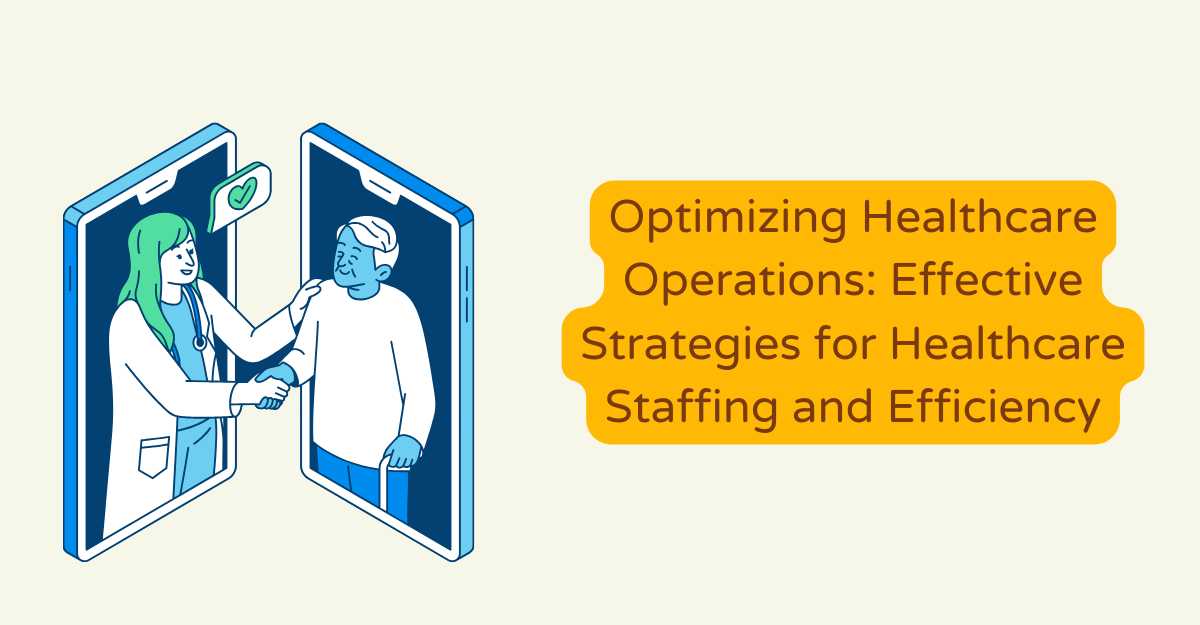
Optimizing Healthcare Operations: Effective Strategies for Healthcare Staffing and Efficiency
In the ever-evolving healthcare system that is built on efficiency and effectiveness, the ability to operate efficiently and at the optimum staffing levels is key to delivering quality patient care, while ensuring optimal resource utilization and minimizing costs. From scheduling patients to staffing schedules, healthcare organizations must use well-thought-out principles so that operations can run fast and staffing levels are always optimal. This blog piece is about the top strategies for the smooth running of healthcare operations and staffing and also about the ways they can be done right. The strategies involve everyday practices and even new approaches to raising productivity and performance levels in healthcare settings.
Balancing Workforce Needs the Significance of the Healthcare Labor Force
An efficient healthcare system primarily relies on effective healthcare staffing, a process of matching the workforce supply to the patient’s demand in such a way that there is no shortage, while the resources are at their optimal use. In healthcare, staffing covers all types of positions, ranging from physicians, nurses, allied health professionals, and administrative and support employees. Every position is equally important because they all contribute to meeting the needs of the patients and supporting the organization as a whole. Through the appropriate retention of staff across various departments and shifts, healthcare providers can uphold patient satisfaction, clinical outcome alignment, and medical rectitude.
Reflection of Efficient Staffing using Data Analytics.
Today, in the data-driven healthcare environment, organizations can utilize advanced analytics tools to forecast patient volumes, predict staffing needs, and make staff allocation efficient. Through appraisal of historical patient data, seasonal patterns, and other relatable parameters healthcare administrators can create predictive staffing models that take into account variances in demand so that staffing levels can be adjusted accordingly. Furthermore, real-time data analytics enables the detection of bottlenecks, the reinventing of workflows, and the reallocation of staff in the interest of greater effectiveness and efficiency.
Implementing Flexible Staffing Models
Flexibility is the main success factor of efficient healthcare staffing, especially in dynamic environments, making the staffing simple to cope with patient volume and acuity which can vary unpredictably. Healthcare organizations can leverage a variety of flexible staffing arrangements such as float pools, per diem staffing, and cross-training initiatives to be able to respond to changes in demand with less potential for overstaffing and understaffing. Cross-training employees across different roles and departments helps in building workforce agility, and this ensures flexibility within the organization to readily deploy staff where they are needed most, such as during peak periods or emergencies.
Capitalizing on Technology for the Human Resource Management
Technology is a very important part of healthcare staffing and workforce management today and provides working standards that are cutting-edge in terms of scheduling, timekeeping, and communications. Automation of workforce management systems can be used to simplify scheduling tasks, improve staff assignments, and harmonize communication between the team members, in consequence, the administrative burden can be reduced and efficiency can be increased. Moreover, by utilizing a mobile application and communication tools the staff members can communicate and collaborate in real-time, thus allowing them to coordinate tasks, share information, and respond to patients’ needs, even if they are remote.
Staff Welfare and work-life balance should be the priority.
Besides making optimum use of staffing levels and workflows healthcare organizations should be based on their staff’s well-being and work-life balance too. Fatigue and burnout are the usual challenges that healthcare workers usually experience, especially the frontline workers who have to deal with high levels of stress every day. Those strategies can be adopted by organizations like putting mental health resources at workers’ disposal, providing flexible scheduling, and creating a work environment where workers can have moral support. This undoubtedly boosts employees’ morale, reduces turnover rates, and eventually improves patient care outcomes.
Conclusion
Hence, top-performing healthcare entities ought to incorporate the mastery of efficient healthcare operations and staffing as part of their core structures which will guarantee top-quality patient care, full utilization of resources, and sound operational performance. Using evidence-based knowledge-based predictive staffing, agile workforce models, technology-enabled workforce management, and putting the staff’s well-being first, healthcare organizations can improve service efficiency and productivity, and raise satisfaction with patients. At the pace of healthcare sector evolvement, healthcare organizations have to remain flexible, adaptable, and responsive in the implementation of innovative approaches geared toward optimizing operations and staffing for the benefit of both healthcare professionals and patients.






